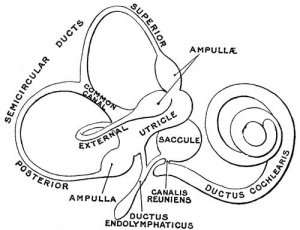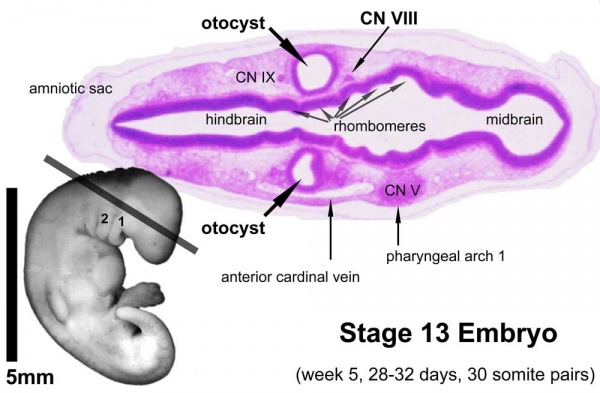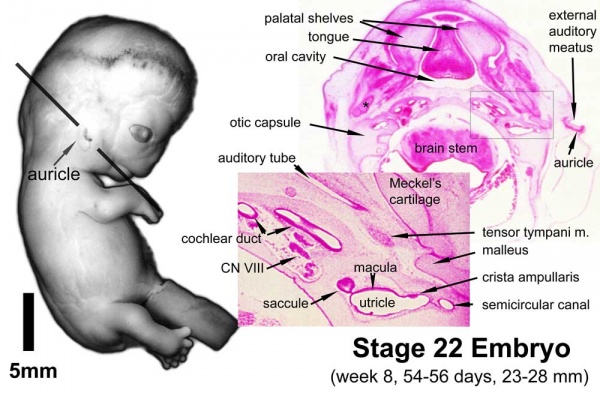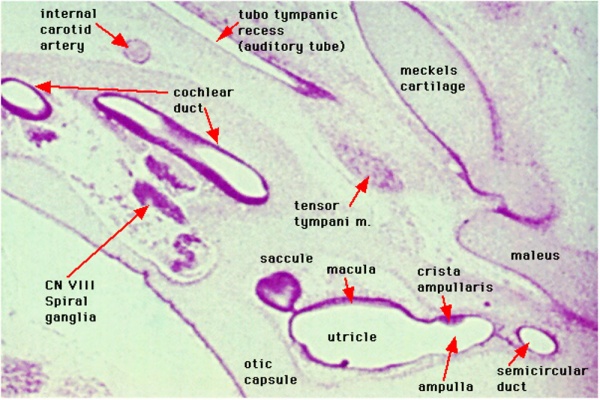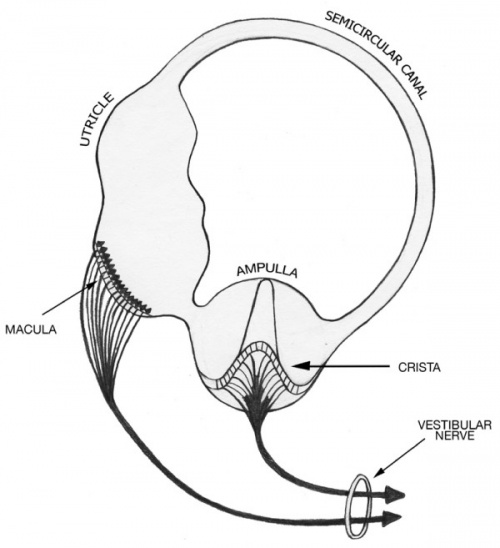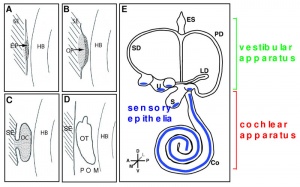Sensory - Balance Development
| Embryology - 27 Apr 2024 |
|---|
| Google Translate - select your language from the list shown below (this will open a new external page) |
|
العربية | català | 中文 | 中國傳統的 | français | Deutsche | עִברִית | हिंदी | bahasa Indonesia | italiano | 日本語 | 한국어 | မြန်မာ | Pilipino | Polskie | português | ਪੰਜਾਬੀ ਦੇ | Română | русский | Español | Swahili | Svensk | ไทย | Türkçe | اردو | ייִדיש | Tiếng Việt These external translations are automated and may not be accurate. (More? About Translations) |
Introduction
The sensory system for balance (or vestibular) arises as part of the inner ear development from the otic placode then otic vesicle. Three flattened pouch of epithelium extend from the otic vesicle from which the final semicircular canals will be fashioned. During early development the epithelia of two apposing wall of the pouch approach each other and form a fusion plate, that clears to form a hole generating the loop of the remaining tissue as semicircular canals. Fusion plate clearing has been suggested to occur due to both apoptosis and epithelial-mesenchymal transition.[1]
The adult semicircular canals are fluid-filled tubules that are arranged perpendicularly to each other in inner ear and remain connected to the cochlea. This tubular arrangement and connection allows fluid movement and detection of head movement in all 3 planes.
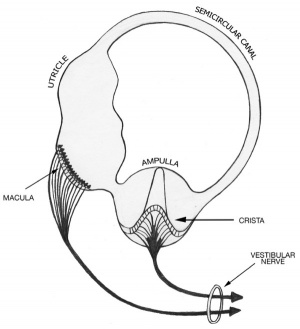
Some Recent Findings
|
| More recent papers |
|---|
|
This table allows an automated computer search of the external PubMed database using the listed "Search term" text link.
More? References | Discussion Page | Journal Searches | 2019 References | 2020 References Search term: Balance Development | Balance Embryology | Vestibular labyrinth Development | Vestibular Development | semicircular canal development | saccule development |
| Older papers |
|---|
| These papers originally appeared in the Some Recent Findings table, but as that list grew in length have now been shuffled down to this collapsible table.
See also the Discussion Page for other references listed by year and References on this current page.
|
Embryonic Inner Ear Labyrinth
Week 5
Week 8
Inner Ear Labyrinth
- Cochlea - Otic vesicle - Otic placode (ectoderm)
- Semicircular canals - Otic vesicle - Otic placode (ectoderm)
- Saccule and utricle - Otic vesicle - Otic placode (ectoderm)
Cranial Nerve VIII
- Auditory component - Otic vesicle and neural crest (ectoderm)
- Vestibular component - Otic vesicle and neural crest (ectoderm)
- The inner ear is derived from a pair of surface sensory placodes (otic placodes) in the head region.
- These placodes fold inwards forming a depression, then pinch off entirely from the surface forming a fluid-filled sac or vesicle (otic vesicle, otocyst).
- The vesicle sinks into the head mesenchyme some of which closely surrounds the otocyst forming the otic capsule.
- The otocyst finally lies close to the early developing hindbrain (rhombencephalon) and the developing vestibulo-cochlear-facial ganglion complex.
- Links: Inner Ear
Vestibular Nerve
Semicircular Canal Development
A study using the chicken model suggests that an epithelial to mesenchymal transition occurs during early development of the semicircular canals.[1]
- "Semicircular canals are sensory organs for balance, consisting of fluid-filled tubules that are arranged perpendicularly to each other in inner ear. The precise mechanism of the morphogenesis of this unique organ is still under investigation. Semicircular canals arise from the flattened pouch of epithelium. The centers of two apposing wall of the pouch approach each other and form a fusion plate. The clearing of the fusion plate makes a hole and leaves the remaining tissue as semicircular canals. Three mechanisms have been proposed for this clearing: programmed cell death, epithelial-mesenchymal transition, and retraction of the cells in the fusion plate to surrounding semicircular canals. Previous studies have revealed programmed cell death in the fusion plate, although other two hypotheses were not disproved. Here we examined the contribution of epithelial-mesenchymal transition and epithelial retraction to the morphogenesis of semicircular canals. We analyzed immunohistochemically the structural change in the epithelium of the developing fusion plate using molecular markers, basal lamina component laminin, cytoskeletal F-actin, and cellular junctional marker beta-catenin. Our observation revealed that fusion plate epithelium lost its apico-basal polarity and intermingled with facing fusion plate cells, associated with the disruption of basal lamina. Moreover, there were several cells with mesenchymal appearance adjacent to the torn basal lamina. We also found the merging of apposing basal laminae at the border between forming canal and breaking fusion plate. These observations suggest that the epithelial-mesenchymal transition, rather than the epithelial retraction, may be responsible for clearing fusion plate cells."[1]
References
- ↑ 1.0 1.1 1.2 Kobayashi Y, Nakamura H & Funahashi J. (2008). Epithelial-mesenchymal transition as a possible mechanism of semicircular canal morphogenesis in chick inner ear. Tohoku J. Exp. Med. , 215, 207-17. PMID: 18648181
- ↑ Pender DJ. (2009). A model analysis of static stress in the vestibular membranes. Theor Biol Med Model , 6, 19. PMID: 19723316 DOI.
- ↑ Deng M, Pan L, Xie X & Gan L. (2010). Requirement for Lmo4 in the vestibular morphogenesis of mouse inner ear. Dev. Biol. , 338, 38-49. PMID: 19913004 DOI.
- ↑ Shall MS. (2009). The importance of saccular function to motor development in children with hearing impairments. Int J Otolaryngol , 2009, 972565. PMID: 20148080 DOI.
- ↑ Ronca AE, Fritzsch B, Bruce LL & Alberts JR. (2008). Orbital spaceflight during pregnancy shapes function of mammalian vestibular system. Behav. Neurosci. , 122, 224-32. PMID: 18298265 DOI.
Reviews
Clarke AH. (2010). Laboratory testing of the vestibular system. Curr Opin Otolaryngol Head Neck Surg , 18, 425-30. PMID: 20717033 DOI.
Chatterjee S, Kraus P & Lufkin T. (2010). A symphony of inner ear developmental control genes. BMC Genet. , 11, 68. PMID: 20637105 DOI.
Articles
Straka H. (2010). Ontogenetic rules and constraints of vestibulo-ocular reflex development. Curr. Opin. Neurobiol. , 20, 689-95. PMID: 20637600 DOI.
Santi PA, Rapson I & Voie A. (2008). Development of the mouse cochlea database (MCD). Hear. Res. , 243, 11-7. PMID: 18603386 DOI.
Bradshaw AP, Curthoys IS, Todd MJ, Magnussen JS, Taubman DS, Aw ST & Halmagyi GM. (2010). A mathematical model of human semicircular canal geometry: a new basis for interpreting vestibular physiology. J. Assoc. Res. Otolaryngol. , 11, 145-59. PMID: 19949828 DOI.
Search PubMed
May 2010 "Inner Ear Development" All (4027) Review (452) Free Full Text (750)
Search Pubmed: Balance Development | Vestibular Development |Semicircular Canal Development
External Links
External Links Notice - The dynamic nature of the internet may mean that some of these listed links may no longer function. If the link no longer works search the web with the link text or name. Links to any external commercial sites are provided for information purposes only and should never be considered an endorsement. UNSW Embryology is provided as an educational resource with no clinical information or commercial affiliation.
- Neuroscience Neuroscience - The Inner Ear
Glossary Links
- Glossary: A | B | C | D | E | F | G | H | I | J | K | L | M | N | O | P | Q | R | S | T | U | V | W | X | Y | Z | Numbers | Symbols | Term Link
Cite this page: Hill, M.A. (2024, April 27) Embryology Sensory - Balance Development. Retrieved from https://embryology.med.unsw.edu.au/embryology/index.php/Sensory_-_Balance_Development
- © Dr Mark Hill 2024, UNSW Embryology ISBN: 978 0 7334 2609 4 - UNSW CRICOS Provider Code No. 00098G
